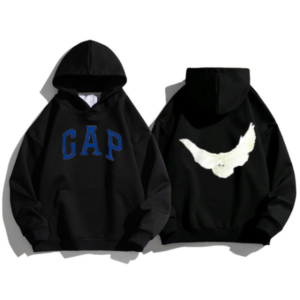
The Hoodie and the Environment Sustainable Choices. Hoodies have become an essential part of modern fashion, beloved for their comfort, versatility, and style. However, as the fashion industry continues to face scrutiny for its environmental impact, many consumers are beginning to reconsider how their clothing choices affect the planet. In response to this growing concern, the hoodie market has seen a shift towards more sustainable practices. Here’s a look at the environmental impact of Stussy Seoul Hoodie and how sustainable choices are making a difference.
The Environmental Impact of Traditional Hoodie Manufacturing
The production of clothing, including hoodies, is a major contributor to environmental degradation. Traditional hoodie manufacturing involves the use of cotton, polyester, and other materials that require large amounts of water, energy, and chemicals. Cotton farming, for instance, uses vast amounts of water and pesticides, while polyester is made from petroleum-based products, contributing to pollution and the depletion of natural resources.
Additionally, the fast fashion industry has accelerated the pace of production, leading to a rise in waste, overproduction, and unsustainable consumption.
Sustainable Materials in Hoodie Production
In recent years, more brands have started to embrace sustainable fabrics for hoodie production. Organic cotton, for example, is grown without harmful pesticides or synthetic fertilizers, making it much more environmentally friendly than conventional cotton. Organic cotton farming uses less water and improves soil health, making it a more sustainable option for hoodie manufacturers thetrapstarhoodie
Another sustainable material making waves is recycled polyester, which is made from post-consumer plastic bottles or recycled garments. This reduces the need for new polyester production, cutting down on plastic waste and conserving resources. Hemp, bamboo, and Tencel are also gaining popularity due to their low environmental impact and natural, biodegradable properties.
Eco-Friendly Dyeing and Printing Techniques
Traditional dyeing processes can be highly polluting, often involving toxic chemicals and large amounts of water. However, sustainable hoodie brands are shifting towards eco-friendly dyeing techniques, such as plant-based dyes or waterless dyeing processes. These methods reduce water consumption and eliminate harmful chemical runoff, making them safer for both the environment and workers.
Similarly, printing methods have also evolved to become more eco-conscious. Water-based inks and natural dyes are now commonly used in hoodie designs, replacing solvent-based inks that release harmful chemicals into the environment. These eco-friendly printing methods result in less pollution and reduce the carbon footprint of each hoodie.
Ethical Manufacturing Practices
Sustainability goes beyond just the materials used in hoodie production; it also extends to the ethical practices of the brands that produce them. Ethical manufacturing reduces the exploitation of workers and ensures that the entire supply chain follows environmentally responsible practices.
Brands that focus on sustainability often have transparent supply chains, allowing consumers to trace the origins of their garments. This transparency helps shoppers make informed choices and supports companies that prioritize ethical and sustainable practices.
Reducing Waste Through Circular Fashion
The concept of circular fashion is gaining traction as an alternative to the traditional linear fashion model, which focuses on creating, consuming, and disposing of garments. In a circular fashion model, clothing is designed to be reused, repaired, or recycled. Brands are increasingly offering take-back programs where consumers can return old hoodies for recycling or repurposing into new products. This helps reduce textile waste and keeps garments out of landfills.
Some brands are even using old garments to create entirely new hoodies, incorporating recycled fabrics or upcycled materials. This reduces the need for virgin resources, minimizes waste, and contributes to a more sustainable fashion industry.
Eco-Friendly Packaging
In addition to sustainable hoodie production, many brands are also focusing on minimizing their environmental impact through eco-friendly packaging. Traditional packaging, such as plastic bags and excess plastic, contributes significantly to waste. However, many hoodie brands are adopting biodegradable packaging materials, such as recycled cardboard, compostable bags, and reusable packaging. This small change reduces waste and supports a circular economy.
Longevity and Timeless Design
Another key element of sustainability is the longevity of the products we purchase. The trend towards “slow fashion” encourages consumers to invest in high-quality, durable items that can last for years rather than cheap, fast-fashion alternatives. This can significantly reduce your environmental impact over time.
The Future of Sustainable Hoodies
The future of hoodie fashion is moving towards even more innovative, sustainable practices. In the coming years, we can expect to see advancements in sustainable fabrics, new recycling technologies, and improvements in the overall production process. Brands that focus on sustainability are likely to continue leading the way in eco-friendly fashion, setting new standards for the industry and encouraging consumers to make more conscious choices.
Additionally, with growing awareness about climate change and environmental issues, consumers are becoming more mindful of the brands they support. The demand for eco-friendly products, including sustainable hoodies, is expected to increase, prompting more companies to adopt sustainable practices.
Conclusion
The hoodie, once seen as a simple piece of clothing, has evolved into a fashion statement that can be both stylish and environmentally responsible. By choosing sustainable materials, supporting ethical brands, and embracing recycling and circular fashion models, we can reduce the environmental impact of our favorite hoodie. Proving that style and sustainability can go hand in hand alazhan







